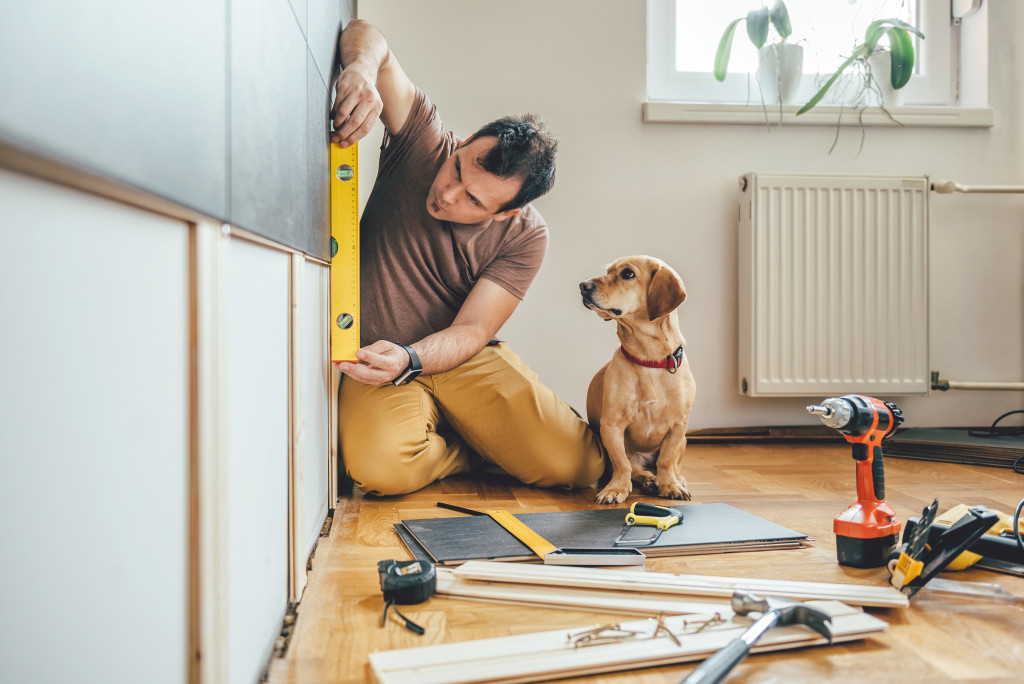According to the Leading Indicator of Remodeling Activity (LIRA) report of the Remodeling Futures Program at Harvard University’s Joint Center for Housing Studies, the rate of homeowners’ improvements and repairs reached 353 billion in the first quarter of 2021 and is projected to reach 370 billion in the first quarter of 2022. The report considers remodeling, structural changes, additions, and replacements as improvements. Repairs include routine maintenance work. Both preserve and improve the quality and value of the homes.
Making a Home Easy to Clean and Disinfect
With the Covid-19 pandemic, cleaning and disinfecting the home has become a top priority. The Centers for Disease Control and Prevention (CDC) released guidelines on what to do regularly, what to do after visitors leave the home, and what to do if anyone at home is sick with the virus. High-touch surfaces such as tables and countertops, doorknobs, handles, and light switches are among the areas that need special attention.
It is necessary to check the compatibility of cleaning products with the surfaces they are used on. For instance, bleach is often used to disinfect but some surfaces will corrode, and some upholstery fabrics will discolor when bleached. When remodeling, it is essential to consider this.
This is why steel is now a popular material in home renovations. Many homeowners are choosing to use stainless steel, most often in kitchens. It is non-porous, easy to clean, and attractive, especially with an industrial type of home design. One thing to look out for when having contractors install stainless steel features is white frosting on the metal. This means that the welders did not use neutralizing fluid and that there may be residual acidity left on the surface. This mars the beauty of the material and can also be dangerous especially when the surface is used for food preparation. Homeowners must make sure this does not happen.
Another material that is easy to clean and disinfect is porcelain. This can be used as large tiles for floors, kitchen backsplashes, toilets, and bathrooms. It comes in various designs and can mimic the look of marble or wood. Porcelain is also used in bathtubs and sinks, as well as kitchen countertop slabs, and is sturdy enough for outdoor use.
When reupholstering furniture and choosing drapes, homeowners must look for fabric types that can tolerate bleach and alcohol. This way, they can spray the fabrics with alcohol or bleach for disinfection.
Paint used on walls must be easy to wipe clean with soap and water. If the walls can be clad in porcelain tiles, instead, they will be easier to keep clean and will last longer without the need for repainting.
Ensuring Good Air Quality

Some fabrics, carpets, rugs, as well as paint, contain volatile organic compounds (VOC) that cause indoor pollution. Homeowners must avoid these. There are low-VOC paints available that are safe even for nurseries. Homeowners with old houses must hire an expert to check if the housepaint contains lead and how to remove these. Some old types of insulation also have harmful emissions and need replacement.
If left unattended, heating, ventilation, and air conditioning (HVAC) systems can develop mold and fungi that affect air quality and the health of occupants. Homeowners must ensure regular maintenance and replacement of UV filters.
Carbon monoxide poisoning is another household danger. According to CDC, about 400 people in the U.S. die from this annually. Leaks or blockages in flues or pipes of certain appliances can cause carbon dioxide emissions. Some of these appliances are furnaces, boilers, gas stoves, gas ovens, fireplaces, water heaters, and clothes dryers.
Homeowners must look out for signs of carbon monoxide emissions. Among these are soot in the fireplace; soot around fuel-burning appliances; rust on flue pipes or appliance jacks; the blue flame of combustion appliances turning orange or yellow; too much moisture and condensation on walls, windows, and cold surfaces; and discolored chimney-top bricks. Homeowners must ensure regular maintenance and also install a carbon monoxide detector in the home.
Plan for Aging in Place
If there are elderly people in the home, or if the occupants plan to stay in the home until they grow old, renovations must consider the requirements of aging in place. They must remember that elderly people usually have difficulty walking and lose their balance easily. They may also need to use a wheelchair at some point. The entrance to the house must have no steps and doorways must be wide. The ground floor must not have uneven flooring or steps. There must be a bedroom and a full bathroom on the ground floor. The bathroom and toilet must be large enough to accommodate a wheelchair and the addition of a shower seat and handrails when necessary.
Healthy Home Design
Any home renovation must focus on the health and wellness of the occupants. Home design elements must prioritize creating a safe environment for everyone. After all, the home is the refuge and sanctuary of its residents.

